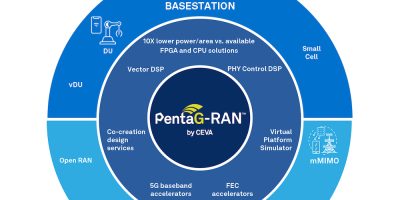Baseband IP is for 5G RAN ASICs
To address the MIMO compute challenges around 5G Open RAN (O-RAN), Ceva has introduced PentaG-RAN which is claimed is the industry’s first baseband IP for ASICs.
The IP for ASICs targets cellular infrastructure in both base station and radio configurations, including distributed units (DU), and remote radio units (RRU), from small cell to massive multiple-input, multiple output (mMIMO). This heterogeneous baseband compute platform has been designed to “significantly reduce the entry barriers” for companies wishing to break into opportunities available in O-RAN equipment.
PentaG-RAN addresses the inability of the current platforms to scale effectively to mMIMO dimensions or support new O-RAN use cases where power and cost are significant factors. The platform for a complete L1 PHY (physical layer 1) with optimal hardware/software partitioning incorporates powerful vector DSPs, PHY control DSPs, flexible 5G hardware accelerators and other specialised components required for modem processing chains. According to Ceva, it delivers up to 10 times savings in power and area compared to available FPGA and commercial off the shelf (COTS) CPU-based alternatives. To further reduce design risk and expediate ASIC design, Ceva offers its co-creation services to PentaG-RAN customers to develop the PHY subsystem which extends up to designing the complete chip.
The PentaG-RAN platform addresses both base station and radio compute configurations. For the base station, it supports macro DU/vDU and small cells with scalability for L1 inline DU/vDU acceleration. This configuration handles the acceleration of the main processing chains (data and control), for both symbol-to-bit domains (including FEC) and frequency processing (including FFT and equalisation). Advanced algorithms including channel estimation and MMSE calculation are mapped to the Ceva-XC DSP for processing and power efficiency. It includes a powerful resource pool for accelerating COTS platforms and supports high and low-PHY 7.2x split partitioning based on Open RAN specifications.
For the radio portion, it supports Open RAN low PHY, massive MIMO and a beamformer for a scalable compute platform for massive MIMO beamforming processing on the RRU side, including beamformer and bBeamforming weight calculation. This configuration offers compute and PPA efficiency, enabling cost reduction and integration options with transceivers, compared to FPGAs and other COTS alternatives. It supports a range of use cases from small cell and macro, to massive MIMO 32TR to 64TR, for both sub-6 and mmWave and supports O-RAN 7.2x splits.
PentaG-RAN is supported by Ceva’s Virtual Platform Simulator (VPS), a unified System-C modelling environment that allows pre-silicon software development, dimensioning, architecture proof-of-concept, and modelling of all platform components. The VPS also includes reference software implementation for main processing chains, as well as beamforming use cases.
PentaG-RAN will be available for general licensing in Q4 2022.




